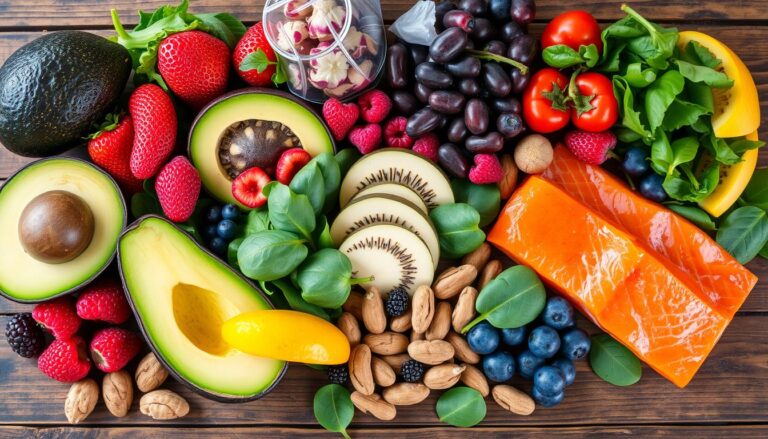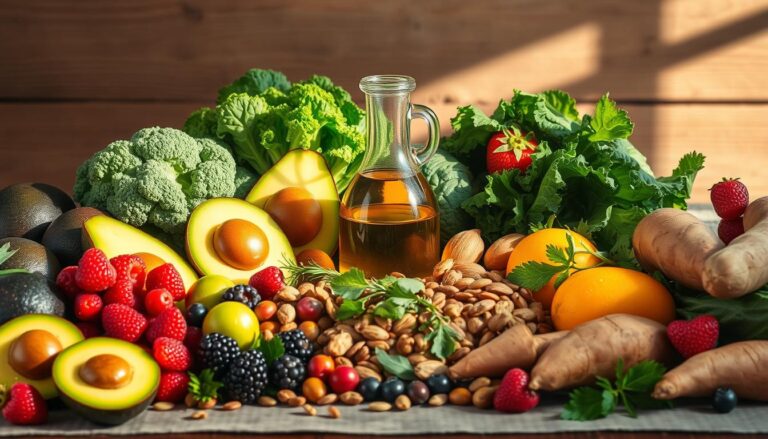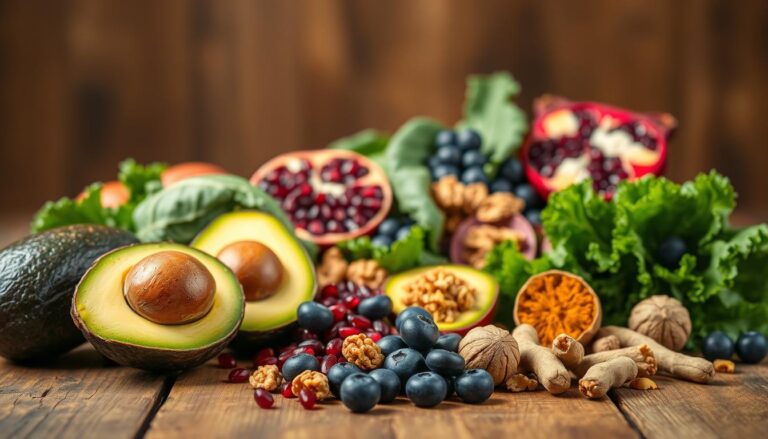In today’s fast world, our heart health is more important than ever. But what if the secret to a stronger heart is in our food? Our heart is the core of our body, and what we eat greatly affects it. So, what foods can make our heart stronger, and how can we add them to our diet?
Key Takeaways
- Certain nutrients like omega-3s, fiber, and antioxidants can boost heart health.
- Incorporating heart-healthy foods like salmon, nuts, and leafy greens can strengthen the cardiovascular system.
- Limiting saturated and trans fats, as well as sodium, is crucial for maintaining a healthy heart.
- Portion control and balanced meal planning are essential for a heart-friendly diet.
- A diverse, plant-based diet rich in whole, minimally processed foods is the foundation of a heart-healthy lifestyle.
Understanding the Connection Between Diet and Heart Health
A heart-healthy diet is key to keeping your heart in top shape. It helps lower the risk of heart disease. Foods rich in certain nutrients can boost heart health. Your diet affects blood pressure, cholesterol, and inflammation levels.
The Role of Nutrients in Cardiovascular Function
Nutrients like omega-3 fatty acids, fiber, potassium, and antioxidants are vital for a healthy heart. Omega-3s in fatty fish like salmon can lower triglycerides and blood pressure. Fiber in whole grains, fruits, and veggies helps control cholesterol and aids in weight management.
Potassium in foods like bananas and leafy greens helps balance sodium. This supports healthy blood pressure.
Impact of Dietary Choices on Heart Health
Research shows a heart-friendly diet can reduce death risk by 31% over 6 years. Eating too much can harm heart health. It can lead to weight gain and related health issues.
Key Components of a Heart-Healthy Diet
- Focus on fruits, veggies, whole grains, lean proteins, and anti-inflammatory foods
- Reduce saturated fats, trans fats, sodium, and added sugars
- Include healthy fats from nuts, seeds, and olive oil
- Keep a balanced, calorie-controlled diet for a healthy weight
Knowing how diet affects heart health helps make better choices. It nourishes your heart and lowers heart disease risk.

What Foods Make the Heart Stronger?
Keeping a heart-healthy diet is key for your heart’s health. The American Heart Association says one in three adults in the U.S. has heart disease. This is a major cause of death. Luckily, many heart-healthy foods can help your heart, lower inflammation, and boost overall heart health.
Fatty fish like salmon and tuna are full of omega-3 fatty acids. These acids can lower blood pressure and cholesterol, cutting down heart disease and stroke risks. 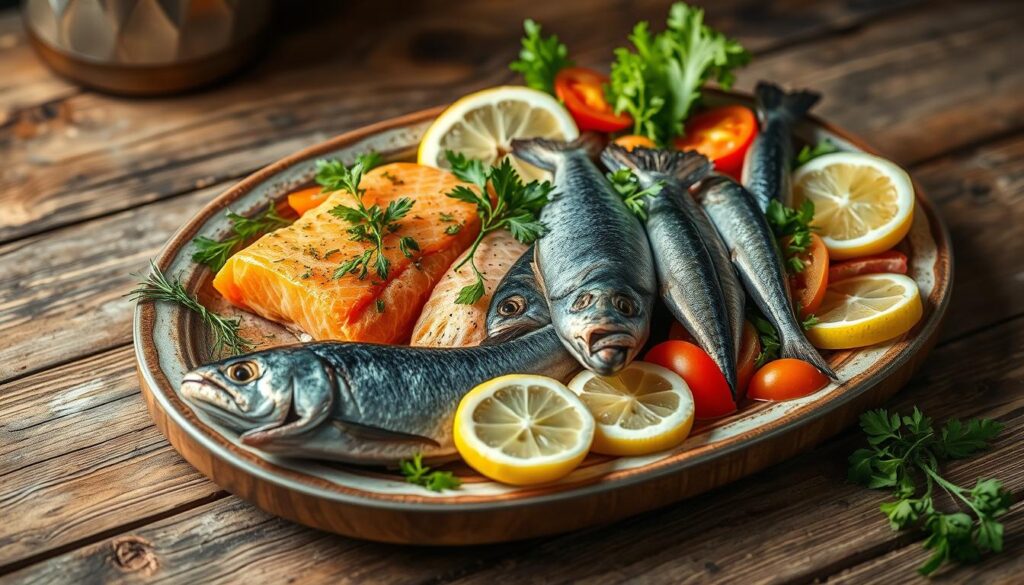
Fruits and veggies rich in antioxidants, like berries, citrus fruits, and leafy greens, are great for your heart. They protect your heart from damage and inflammation. Studies show that anthocyanin-rich berries and flavonoid-rich citrus fruits can lower heart disease and stroke risks.
Whole grains, nuts, seeds, and olive oil are also good for your heart. They offer important nutrients, healthy fats, and fiber that help your heart work well. Legumes, like beans and peas, are also good because they’re high in fiber and protein.
Eating these antioxidant-rich foods can help you stay heart-healthy. It’s a smart way to lower your risk of heart disease.
Essential Fish and Seafood for Heart Health
Fatty fish and seafood are key for a heart-healthy diet. They are full of omega-3 fatty acids. These acids help lower heart rhythm disorders and blood pressure.
Benefits of Salmon and Fatty Fish
Fatty fish like salmon, mackerel, and tuna are rich in omega-3s. The American Heart Association suggests eating these fish at least twice a week. Each serving should be about 4 ounces (113 grams).
Eating these fish can help your heart in many ways. It can reduce inflammation and improve cholesterol levels.
Recommended Portions and Preparation Methods
Most adults should aim for two servings of omega-3-rich fish per week. Grilling, baking, or broiling fish is best. These methods avoid the extra fats and calories of deep-frying.
Omega-3 Rich Alternatives
If you don’t eat fish often, there are other options. Flaxseeds, walnuts, and algae-based supplements are also good for your heart. They provide the omega-3 fatty acids your heart needs.
“Eating at least two servings of fish a week could reduce the risk of heart disease.”
Heart-Boosting Fruits and Vegetables
Adding antioxidant-rich foods to your diet is key for heart health. Fruits and vegetables are full of vitamins, minerals, and fiber. These nutrients help strengthen the heart and lower heart disease risk.
Berries like blueberries, raspberries, and blackberries are great. They’re small but full of antioxidants. These protect the heart from damage and inflammation. Citrus fruits, such as oranges and grapefruits, are also good. They have pectin, which fights cholesterol, and potassium, which helps control blood pressure.
Leafy greens like Swiss chard, kale, and spinach are also important. They’re full of fiber, potassium, magnesium, and antioxidants. These nutrients support heart function and lower heart disease risk.
Try to eat a variety of colorful produce. Each color has different plant compounds that are good for the heart. Eating a rainbow of fruits and vegetables gives you many heart-boosting nutrients.
“Eating a diet rich in fruits and vegetables is one of the best ways to support heart health and reduce the risk of cardiovascular disease.”

Make fruits and vegetables a big part of your diet. They give your body essential antioxidants, fiber, and other nutrients. These keep your heart strong and resilient.
Whole Grains and Fiber for Cardiovascular Health
Whole grains are great for a healthy heart. They help lower cholesterol and control blood sugar. Barley, oats, and quinoa are top choices for heart health.
Benefits of Barley, Oats, and Quinoa
Barley is full of fiber that lowers cholesterol. It also has lots of good nutrients. Oats are known for their fiber, which is good for the heart. Quinoa is an ancient grain with fiber, minerals, and antioxidants for a healthy heart.
Daily Recommended Intake
The American Heart Association says to eat at least three servings of whole grains a day. This can be whole-wheat bread, oatmeal, or cooked quinoa. Eating more of these fiber-rich foods helps your heart.
Smart Grain Substitutions
- Swap white rice for brown rice or other whole grains like farro or barley.
- Choose whole-wheat bread over refined, white bread.
- Opt for oatmeal or quinoa-based cereals instead of processed, sugary options.
By making these simple dietary choices for heart health, you can add more fiber-rich foods to your diet. This supports your heart’s health.
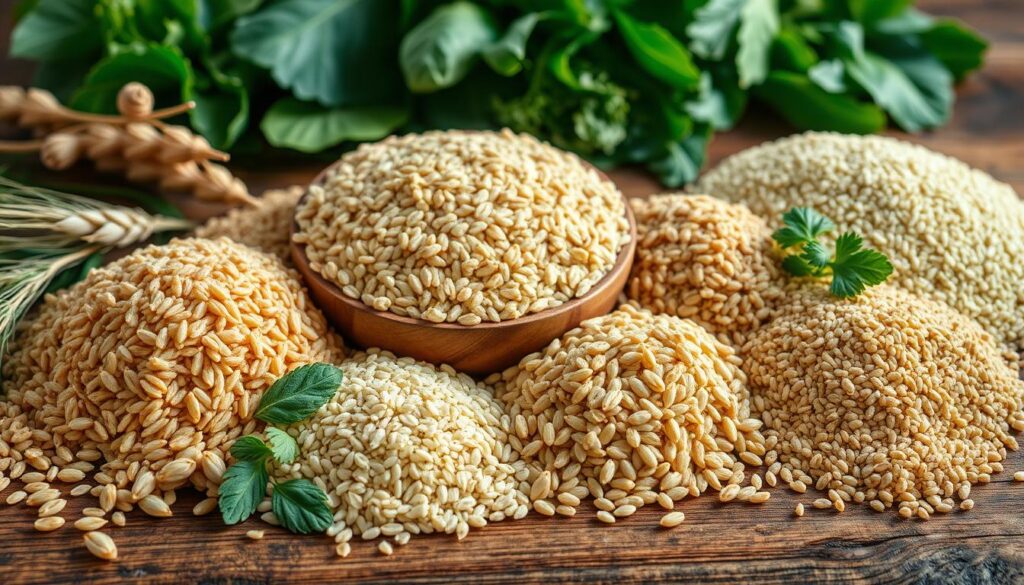
“Whole grains are a key feature of the American Heart Association’s dietary recommendations for a reason – they lower the risk for heart disease and stroke.”
Nuts, Seeds, and Healthy Fats
Nuts and seeds are packed with nutrients that are great for your heart. They are full of unsaturated fats, fiber, and plant sterols. These help keep your heart healthy.
Walnuts are rich in omega-3 fatty acids. These acids help lower inflammation and heart disease risk. Almonds are good for lowering LDL (bad) cholesterol levels. They have monounsaturated fats and antioxidants.
Flaxseeds are a great source of omega-3s, lignans, and fiber. These nutrients are good for your heart. Olive oil is also heart-healthy. It’s full of antioxidants that protect blood vessels.
It’s key to watch how much you eat nuts and seeds because they have a lot of calories. Aim for 4 to 6 servings of unsalted nuts a week. That’s about 15 grams, or 3-4 handfuls, a day.
| Nut/Seed | Nutrition (per 1 oz serving) |
|---|---|
| Walnuts | 185 calories, 18.5 g fat, 4.3 g protein, 2 g fiber, 2.5 g omega-3s |
| Almonds | 164 calories, 14.2 g fat, 6 g protein, 3.5 g fiber |
| Flaxseeds | 55 calories, 4.3 g fat, 1.9 g protein, 2.8 g fiber, 1.6 g omega-3s |
| Olive Oil | 119 calories, 13.5 g fat, 0 g protein, 0 g fiber |
Eating these heart-healthy foods can help your heart in many ways. They improve artery health, reduce inflammation, and lower blood pressure and heart disease risk.
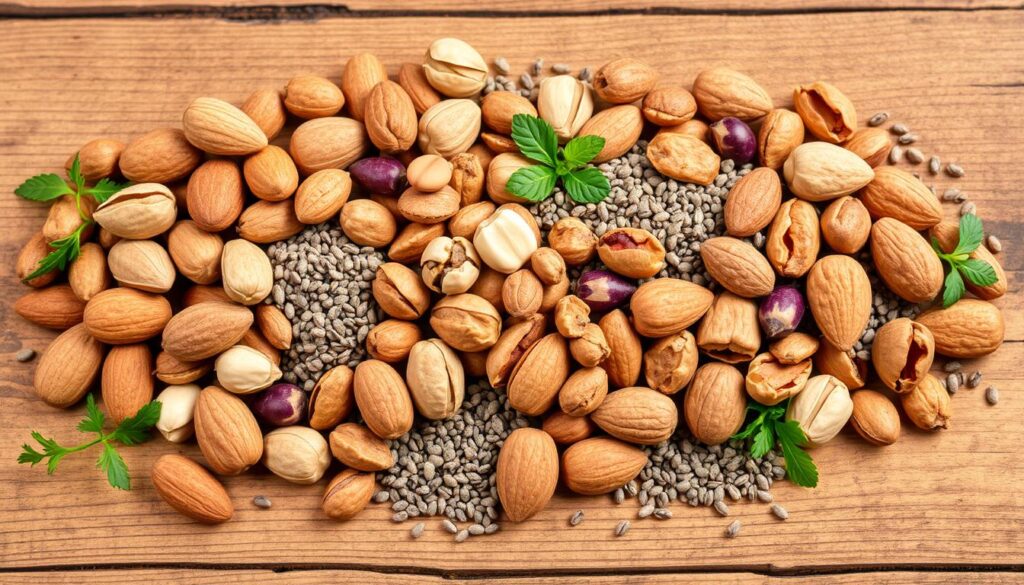
Plant-Based Proteins and Heart Health
Eating plant-based proteins is good for your heart. Foods like beans, lentils, and chickpeas are full of fiber. This fiber helps control cholesterol and blood sugar, which are key for a healthy heart. Soy products like tofu and edamame also offer complete proteins and may lower cholesterol.
Benefits of Legumes and Soy Products
Legumes and soy products are great for your heart. The fiber in foods like beans and lentils cleans out bad fats and LDL cholesterol. This helps prevent blockages in blood vessels.
Studies show that eating a lot of fiber can also improve your cholesterol levels. This is important for avoiding heart disease.
Soy products, like tofu and edamame, are complete proteins. They have all the amino acids your body needs. Eating soy can help lower cholesterol and reduce heart disease risk.
Incorporating Plant Proteins into Your Diet
- Add beans, lentils, or chickpeas to salads, soups, and stews for an extra fiber and protein boost.
- Swap out meat for plant-based protein sources like tofu or tempeh in stir-fries and casseroles.
- Snack on edamame or roasted chickpeas for a heart-healthy crunch.
- Experiment with plant-based protein powders, such as pea or soy protein, in smoothies and shakes.
By making simple swaps and adding more plant-based proteins to your meals, you can support your heart health. Enjoy the benefits of a heart-friendly diet and keep your cardiovascular system strong.
“A diet focused on whole, minimally processed plant-based foods, rather than refined or processed options, is essential for heart health as they offer numerous benefits including improved blood sugar management and increased satiety.”
Foods to Limit or Avoid for Heart Health
For a healthy heart, watch what you eat. A diet rich in whole foods is key. But, some foods can harm your heart. Knowing which to avoid helps keep your heart strong.
Saturated and trans fats are bad for your heart. They can increase cholesterol and heart disease risk. Eat less fatty meats, full-fat dairy, and processed snacks. Instead, choose unsaturated fats in avocados, nuts, and olive oil.
Also, cut down on added sugars and refined carbs. Too much can lead to weight gain, inflammation, and diseases like diabetes and high blood pressure. Go for whole grains and fiber-rich foods. Limit sweets and processed foods.
Don’t forget about sodium. The American Heart Association says to keep it under 2,300 mg a day. Aim for 1,500 mg if you can. Use low-sodium options, read labels, and cook at home to control sodium.
By avoiding these harmful foods, you’re on the right path to a heart-healthy life. This can lower your risk of heart disease.
“Eating a heart-healthy diet is one of the most important things you can do to reduce your risk of heart disease and stroke.”
– American Heart Association
Strategies for a Heart-Healthy Diet
To have a heart-healthy diet, focus on two main strategies: portion control and meal planning. These methods help feed your heart and boost your overall health.
Portion Control Guidelines
It’s important to keep your portions right for heart health. Use smaller plates to control how much you eat. The plate method is a good guide: vegetables should fill half, lean protein a quarter, and whole grains the last quarter. This way, you eat the right amounts of healthy foods.
Meal Planning Tips
- Plan your meals ahead to get the nutrients you need. This helps you make better choices and avoid unhealthy ones.
- Make your meals colorful and varied to get more nutrients. Try to include a rainbow of fruits and veggies for vitamins and antioxidants.
- Use healthy fats like olive oil, avocado, and nuts for flavor and heart health.
- Try to eat less processed food, which is often bad for your heart. Choose whole foods instead.
By using portion control and meal planning, you can make a diet that’s good for your heart. It will help your body stay healthy and strong.
“A heart-healthy diet can help reduce total cholesterol and bad (or LDL) cholesterol, lower blood sugars, triglycerides, and decrease blood pressure.”
| Heart-Healthy Recommendations | Optimal Intake |
|---|---|
| Fruits and Vegetables | 7-9 servings per day |
| Omega-3-rich Fish | 2-3 times per week |
| Dietary Fiber | 25 or more grams per day |
| Whole Grains | 3-6 servings per day |
| Lowfat or Nonfat Dairy | Moderate intake |
Conclusion
Eating right is key to keeping your heart healthy and lowering heart disease risk. Include foods like fatty fish, fruits, veggies, whole grains, and healthy fats. Avoid processed and high-fat foods. This change, along with exercise and managing stress, helps your heart and overall health.
Heart health is serious. About 6 million people live with heart failure, with half dying within 5 years after diagnosis. Eating foods high in omega-3s, fiber, and antioxidants can greatly improve heart health.
Follow the American Heart Association and American College of Cardiology’s advice for a heart-healthy diet. This diet not only feeds your body but also lowers heart disease risk. Making heart-healthy choices is crucial for a strong heart and a longer, happier life.
